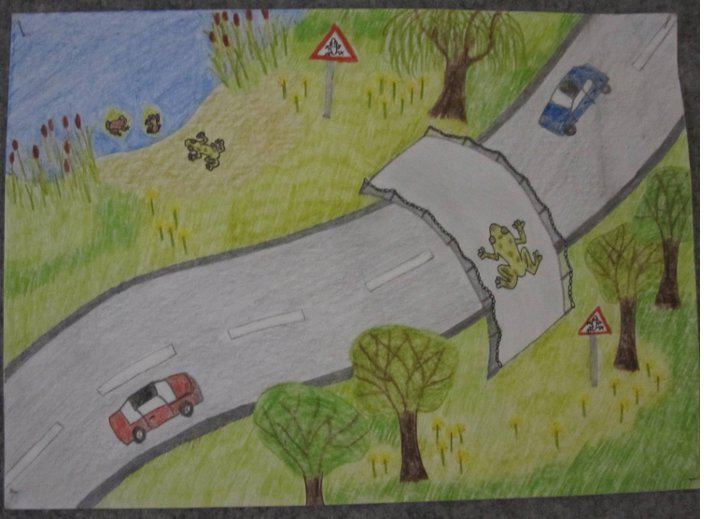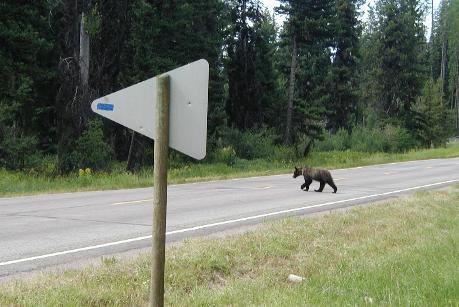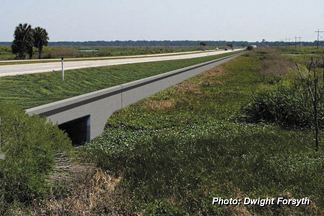Highway to help road ecology in canada
Road ecology is the study of the ecological impacts (both positive and negative) of roads and highways (public roads). These effects may include local effectssuch as on noise, water pollution, habitat destruction/disturbance and local air quality; and wider effects such as habitat fragmentation, ecosystem degradation, and climate change from vehicle emissions. The design, construction and management of roads, parking and other related facilities as well as the design and regulation of vehicles can change the impacts to varying degrees. Roads are known to cause significant damage to forests, prairies, streams and wetlands. Besides the direct habitat loss due to the road itself, and the roadkill of animal species, roads alter water-flow patterns, increase noise, water, and air pollution, create disturbance that alters the species composition of nearby vegetation thereby reducing habitat for local native animals, and act as barriers to animal movements. Roads are a form of linear infrastructure intrusion that has some effects similar to infrastructure such as railroads, power lines, and canals, particularly in tropical forests.
Contents
- Highway to help road ecology in canada
- Road ecology youtube
- Air quality
- Negative impacts
- Positive impacts
- Hydrology
- De icing chemicals
- Noise
- Habitat fragmentation
- Amphibians and reptiles
- Birds
- Facilitation of poaching of flora and fauna
- Awareness
- Road permeability
- Habitat construction and planting
- Recycling
- References
Road ecology is practiced as a field of inquiry by a variety of ecologists, biologists, hydrologists, engineers, and other scientists. There are several global centers for the study of road ecology: 1) The Road Ecology Center at the University of California, Davis, which was the first of its kind in the world; 2) the Centro Brasileiro de Estudos em Ecologia de Estradas at the Federal University of Lavras, Brazil; 3) The Center for Transportation and the Environment, North Carolina State University; and 4) the Road Ecology Program at the Western Transportation Institute, Montana State University. There are also several important global conferences for road ecology research: 1) Infra-Eco Network Europe (IENE), which is international, but focused primarily on Europe; 2) International Conference on Ecology and Transportation (ICOET), which is also global in scope, but primarily focused on the US; 3) Australasian Network for Ecology & Transportation (ANET), which focuses on the Australasian (sub)continent; and 4) a potential Southern African road ecology conference, being considered by the Endangered Wildlife Trust.

Road ecology youtube
Air quality
Roads can have both negative and positive effects on air quality.
Negative impacts

Air pollution from fossil (and some biofuel) powered vehicles can occur wherever vehicles are used and are of particular concern in congested city street conditions and other low speed circumstances. Emissions include particulate emissions from diesel engines, NOx, volatile organic compounds, carbon monoxide and various other hazardous air pollutants including benzene. Concentrations of air pollutants and adverse respiratory health effects are greater near the road than at some distance away from the road. Road dust kicked up by vehicles may trigger allergic reactions. Carbon dioxide is non-toxic to humans but is a major greenhouse gas and motor vehicle emissions are an important contributor to the growth of CO2 concentrations in the atmosphere and therefore to global warming.
Positive impacts

The construction of new roads which divert traffic from built-up areas can deliver improved air quality to the areas relieved of a significant amount of traffic. The Environmental and Social Impact Assessment Study carried out for the development of the Tirana Outer Ring Road estimated that it would result in improved air quality in Tirana city center.

A new section of road being built near Hindhead, UK, to replace a four-mile section of the A3 road, and which includes the new Hindhead Tunnel, is expected by the government to deliver huge environmental benefits to the area including the removal of daily congestion, the elimination of air pollution in Hindhead caused by the congestion, and the removal of an existing road which crosses the environmentally sensitive Devil's Punchbowl area of outstanding natural beauty. (UTC)
Hydrology
Urban runoff from roads and other impervious surfaces is a major source of water pollution. Rainwater and snowmelt running off of roads tends to pick up gasoline, motor oil, heavy metals, trash and other pollutants. Road runoff is a major source of nickel, copper, zinc, cadmium, lead and polycyclic aromatic hydrocarbons (PAHs), which are created as combustion byproducts of gasoline and other fossil fuels.
De-icing chemicals and sand can run off into roadsides, contaminate groundwater and pollute surface waters. Road salts (primarily chlorides of sodium, calcium or magnesium) can be toxic to sensitive plants and animals. Sand can alter stream bed environments, causing stress for the plants and animals that live there.
De-icing chemicals
The chemicals applied to roads along with grit for de-icing are primarily Salt and calcium chloride. Other chemicals such as urea are also used. These chemicals leave the road surface either in water runoff or in water spray. Vegetation can be damaged by salt as far as 100 m (110 yd) from the road. An increased level of chloride in water due to salt application to roads can be widespread in waterways, rather than a local phenomenon of the road edge itself.
Noise
Motor vehicle traffic on roads will generate noise.
Negative impacts
Noise pollution is a factor of environmental degradation that is often overlooked and typically seen as not having a significant impact, though traffic noise can contribute to numerous disturbances for wildlife. Few studies have been done on road ecology, and even fewer on the effects of noise on wildlife, though one study revealed that noise can have a negative impact, particularly on birds. Noise from major roads can interrupt the calls of song birds, and their instinctive calls associated with mating, communication, migration, and other purposes are hindered by noise from roads. This did not necessarily directly provide a fatal effect for the tested birds, but the study showed that species abundance declined around major roads due to noise.
Road noise can be a nuisance if it impinges on population centres, especially for roads at higher operating speeds, near intersections and on uphill sections. Noise health effects can be expected in such locations from road systems used by large numbers of motor vehicles. Noise mitigation strategies exist to reduce sound levels at nearby sensitive receptors. The idea that road design could be influenced by acoustical engineering considerations first arose about 1973.
Speed bumps, which are usually deployed in built-up areas, can increase noise pollution. Especially if large vehicles use the road and particularly at night.
Positive impacts
New roads can divert traffic away from population centres thus relieving the noise pollution. A new road scheme planned in Shropshire, UK promises to reduce traffic noise in Shrewsbury town centre.
Habitat fragmentation
Roads can act as barriers or filters to animal movement and lead to habitat fragmentation. Many species will not cross the open space created by a road due to the threat of predation and roads also cause increased animal mortality from traffic. This barrier effect can prevent species from migrating and recolonising areas where the species has gone locally extinct as well as restricting access to seasonally available or widely scattered resources.
Habitat fragmentation may also divide large continuous populations into smaller more isolated populations. These smaller populations are more vulnerable to genetic drift, inbreeding depression and an increased risk of population decline and extinction.
Another negative effect is the amount of space roads take up. When cutting through forests, they prevent the growth of many trees as trees can not grow through paved roads. On unpaved roads, vehicle tires and foot traffic compact soil and prevent plant growth. As trees take up CO2 and as they also house animals, this increases the environmental damage inflicted.
Amphibians and reptiles
Roads can be particularly hazardous to populations of amphibians and reptiles that migrate to vernal pools, or to the gravel on road verges that several species try to use as nest sites. Reptiles’ instinctive activities can lead them towards roads and lead to an increase in mortality rates: snakes, for example, may use roads as a source of heat for thermoregulation. Also some turtles have been noted to lay their eggs on road shoulders. Migratory patterns from season to season can also bring frogs and snakes into contact with roads and lead to an increase in their mortality rates.
Birds
The traffic load near large cities may show dramatic cyclical changes induced by weekend tourism, and this could induce cyclical changes in the activity patterns of birds.
Facilitation of poaching of flora and fauna
Roads that run through forests that house edible animals may encourage or facilitate poaching. Especially in poor areas, the construction of roads has promoted not only poaching for personal consumption but also for sale (for consumption or as a pet) to third parties.
Similarly, the construction of roads in forested areas has also promoted illegal logging as it becomes easier for illegal loggers to transport the wood.
Awareness
Awareness needs to be spread among drivers particularly those driving on forest road on maintaining speed limits and being vigilant. Environment Conservation Group had initiated an awareness drive named PATH an acronym for Provide Animals safe Transit on Highways covering more than 17,000 km in India to highlighting the importance of safe driving on forest roads.
Road permeability
Wildlife crossings that allow animals to safely cross human-made barriers such as roads, are intended not only to reduce roadkill, but ideally to provide connectivity of habitat areas, combating habitat fragmentation. Wildlife crossings may include: underpass tunnels, viaducts, and overpasses.
Habitat construction and planting
In Washington County, North Carolina, along Highway 64, a study was conducted to analyze the effects of wildlife underpasses on the local wildlife. Three wildlife underpasses were built with fencing around the highway in the study zones. The study showed that deer used the underpasses the most and made up 93% of all crossings. Mortality rates were calculated and showed that the numbers of deaths were lower near underpasses. This cannot be said about all animals. Some have smaller home ranges so they were not inclined to travel to underpasses to cross the road. Underpass would most likely benefit larger mammals such as bears, deer, and cougars. Underpasses were seen to lower mortality rates and increase local species ability to adapt to a habitat along a major road.
Recycling
Materials removed from a road can be reused in construction within the same project or in other locations. Road construction can also use waste materials from other industries.
Asphalt pavement is one of the most recycled materials in the United States. It is estimated that over 80% of asphalt pavement removed from roadways is reused as construction aggregate. It can be mixed into new pavement or used as a subbase or fill material. Similarly, concrete from road or building demolition can be an excellent source of aggregate.
Common examples of waste products used in road building include coal fly ash (used to make concrete stronger), asphalt shingles and shredded tires (used in asphalt pavement), ground glass and steel mill slag (used as aggregates).
In 2012, US asphalt plants used an estimated 68.3 million tons of reclaimed asphalt pavement, 1.86 million tons of recycled asphalt shingles, and over 1 million tons of other recycled materials to produce new asphalt.
